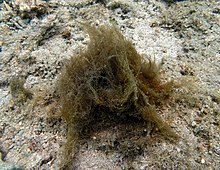Lyngbya majuscula
Appearance
| Lyngbya majuscula | |
|---|---|

| |
| Lyngbya majuscula at Réunion | |
| Scientific classification | |
| Domain: | Bacteria |
| Phylum: | Cyanobacteria |
| Class: | Cyanophyceae |
| Order: | Oscillatoriales |
| Family: | Oscillatoriaceae |
| Genus: | Lyngbya |
| Species: | L. majuscula
|
| Binomial name | |
| Lyngbya majuscula | |
Lyngbya majuscula is a species of filamentous cyanobacteria in the genus Lyngbya. Tropical marine strains, including many producing bioactive compounds, have been separated as the new species Moorea producens.[1] Antillatoxin and Kalkitoxin have been extracted from this microbe.[2] L. majuscula is the cause of seaweed dermatitis.[3]
References
- ^ Engene N, Rottacker EC, Kaštovský J, Byrum T, Choi H, Ellisman MH, Komárek J, Gerwick WH (2012). "Moorea producens gen. nov., sp. nov. and Moorea bouillonii comb. nov., tropical marine cyanobacteria rich in bioactive secondary metabolites". Int. J. Syst. Evol. Microbiol. 62 (Pt 5): 1171–1178. doi:10.1099/ijs.0.033761-0. PMC 3542135. PMID 21724952.
- ^ Osborne, Nicholas J.T.; Webb, Penny M.; Shaw, Glen R. (November 2001). "The toxins of Lyngbya majuscula and their human and ecological health effects". Environment International. 27 (5): 381–392. doi:10.1016/S0160-4120(01)00098-8.
- ^ James, William D.; Berger, Timothy G.; et al. (2006). Andrews' Diseases of the Skin: clinical Dermatology. Saunders Elsevier. ISBN 978-0-7216-2921-6.
